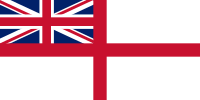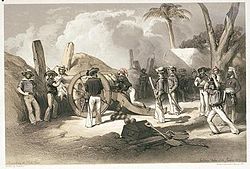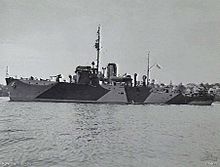Royal Indian Navy
| Royal Indian Navy | |
|---|---|
| Active | 1 May 1830 – 26 January 1950 |
| Country | |
| Branch | Navy |
| Garrison/HQ | Bombay |
| Engagements | Seven Years' War Capture of East India Company ship Nautilus Anglo-Burmese Wars First Opium War Second Opium War First World War Second World War |
| Insignia | |
| Naval Ensign (1928-1950) |  |
| Naval Ensign (1879-1928) & Naval Jack (1928-1947) |  |
The Royal Indian Navy (RIN) was the naval force of British India and the Dominion of India. Along with the Presidency armies, later the Indian Army, and from 1932 the Indian Air Force, it was one of the Armed Forces of British India.
From its origins in 1612 as the East India Company's Marine, the Navy underwent various changes, including changes to its name. Over time it was named the Bombay Marine (1686), the Bombay Marine Corps (1829), the Indian Navy (1830), Her Majesty's Indian Navy (1858), the Bombay and Bengal Marine (1863), the Indian Defence Force (1871), Her Majesty's Indian Marine (1877) and the Royal Indian Marine (1892). It was finally named as the Royal Indian Navy in 1934. However, it remained a relatively small force until the Second World War, when it was greatly expanded.
After the partition of India into two independent states in 1947, the Navy's assets and personnel were split with the new Royal Pakistan Navy. Approximately two thirds of the fleet remained with the Union of India, as did all land assets within its territory, and this force, still under the name of "Royal Indian Navy", became the navy of the Dominion of India until the country became a republic on 26 January 1950. It was then renamed as the Indian Navy.
History
East India Company
1612–1830, the Bombay Marine
The East India Company was established in 1599, and it began to create a fleet of fighting ships in 1612, soon after Captain Thomas Best defeated the Portuguese at the Battle of Swally. This led the Company to build a port and to establish a small navy based at Suvali, In Surat, Gujarat, to protect its trade routes. The Company named the force the 'Honourable East India Company's Marine', and the first fighting ships arrived on 5 September 1612.[1]
This force protected merchant shipping off the Gulf of Cambay and the rivers Tapti and Narmada. The ships also helped map the coastlines of India, Persia and Arabia.[2] During the 17th century, the small naval fleet consisted of a few English warships and a large number of locally built gunboats of two types, ghurabs and gallivats, crewed by local fishermen. The larger ghurabs were heavy, shallow-draft gunboats of 300 tons (bm) each, and carried six 9 to 12-pounder guns; the smaller gallivats were about 70 tons (bm) each and carried six 2 to 4-pounder guns.[3] In 1635, the East India Company established a shipyard at Surat, where they built four pinnaces and a few larger vessels to supplement their fleet.[4]
In 1686, with most of the English commerce moving to Bombay, the force was renamed the "Bombay Marine".[1] This force fought the Marathas and the Sidis and took part in the Anglo-Burmese Wars. While it recruited Indian sailors extensively, it had no Indian commissioned officers.[2]
Commodore William James was appointed to command the Marine in 1751. On 2 April 1755, commanding the Bombay Marine's ship Protector, he attacked the Maratha fortress of Tulaji Angre at Severndroog between Bombay and Goa. James had instructions only to blockade the stronghold, but he was able to get close enough to bombard and destroy it.[2]
In February 1756, the Marine supported the capture of Gheriah (Vijaydurg Fort) by Robert Clive and Admiral Watson, and was active in skirmishes against the French, helping to consolidate the British position in India.[2] In 1809, a fleet of 12 ships of the Marine bombarded the city of Ras al-Khaimah, a pirate stronghold, in an unsuccessful attempt to quell Arab piracy. A subsequent mission in 1819 with 11 vessels proved successful in blockading the city for four days, after which the tribal chieftain surrendered. In 1829, the "Bombay Marine" received the additional name of "Corps", and also received its first steam-powered vessel in that year, the SS Hugh Lindsay of 411 tons. Steaming from Bombay on 20 March 1830, Hugh Lindsay reached Suez after 21 days under steam, at an average speed of six knots.[5]
1830–1858

In 1830, the Bombay Marine was renamed the "Indian Navy". The British capture of Aden increased its commitments, leading to the creation of the "Indus Flotilla". The Navy then took part in the First Opium War of 1840.[2] By 1845, the Indian Navy had completed the conversion from sail to steam.[5]
In 1848, an Indian Navy contingent of 100 ratings and seven officers took part in the Siege of Multan during the Anglo-Sikh War.[6] In 1852, at the outset of the Second Anglo-Burmese War, ships of Her Majesty's Indian Navy joined a Royal Navy force under the command of Admiral Charles Austen to assist General Godwin in the capture of Martaban and Rangoon.[7]
Direct British rule in India
After the end of Company rule in India following the Indian rebellion of 1857, the force came under the command of the British government of India and was formally named "Her Majesty's Indian Navy".[2]
1858–1934
Her Majesty's Indian Navy resumed the name "Bombay Marine" from 1863 to 1877, when it was renamed "Her Majesty's Indian Marine" (HMIM). The Marine then had two divisions; an Eastern Division at Calcutta and a Western Division at Bombay.
In recognition of its fighting services, HMIM was given the title of "Royal Indian Marine" in 1892. By this time it consisted of over fifty vessels.[8] In 1905, the service was described as having "Government vessels engaged in troop-ship, surveying, police or revenue duties in the East Indies".[9]
When mines were detected off the coasts of Bombay and Aden, during the First World War, the Royal Indian Marine went into action with a fleet of minesweepers, patrol vessels and troop carriers. Besides patrolling, the Marine ferried troops and carried war stores from India to Mesopotamia (now Iraq), Egypt and East Africa.
The first Indian to be granted a commission was Engineer Sub-Lieutenant D. N. Mukherji, who joined the Royal Indian Marine as an officer on 6 January 1923.[10]
1934–1945

In 1934 the Royal Indian Marine changed its name, with the enactment of the Indian Navy (Discipline) Act of 1934. The Royal Indian Navy was formally inaugurated on 2 October 1934, at Bombay.[11] Its ships carried the prefix HMIS, for His Majesty's Indian Ship.[12]
At the start of the Second World War, the Royal Indian Navy was small, with only eight warships. The onset of the war led to an expansion in vessels and personnel described by one writer as "phenomenal". During the War, the Women's Royal Indian Naval Service was established, for the first time giving women a role in the navy, although they did not serve on board its ships.[11]
The sloops HMIS Sutlej and HMIS Jumna played a role in Operation Husky, the Allied invasion of Sicily.[13]
Mutiny of 1946
In February 1946, Indian sailors launched the Royal Indian Navy Mutiny on board more than fifty ships and in shore establishments, protesting about alleged discrimination against Indian sailors and officers by the British during the war.[14] The mutiny found widespread support and spread all over India, including the Army and the Air Force. A total of seventy-eight ships, twenty shore establishments and 20,000 sailors were involved in this mutiny.
Independence and Partition of India, 1947
Following India's independence in 1947 and the ensuing partition, the Royal Indian Navy was divided between the newly independent Union of India and Dominion of Pakistan, and the Armed Forces Reconstitution Committee divided the ships and men of the Royal Indian Navy between India and Pakistan. The division of the ships was on the basis of two-thirds of the fleet to India, one third to Pakistan.[15]
The committee allocated to the Royal Pakistan Navy" (RPN) three of the seven active sloops, HMIS Godaveri, HMIS Hindustan and HMIS Narbada, four of the ten serviceable minesweepers, two frigates, two naval trawlers, four harbour launches and a number of harbour defence motor launches. 358 personnel, and 180 officers, most of whom were Muslims or Europeans, volunteered to transfer to the RPN. India retained the remainder of the RIN's assets and personnel, and many British officers opted to continue serving in the RIN.[11]
On 26 January 1950, when India adopted its current constitution and became a republic, the "Royal Indian Navy" was renamed the Indian Navy. The Union Jack in the canton of the White Ensign was replaced with the Tiranga. Its vessels were redesignated as "Indian Naval Ships", and the "HMIS" ship prefix for existing vessels was changed to 'INS'.[16]
Commanding Officers
Director of HM Indian Marine (1876–1892)
- Captain H.W. Brent RN (1876–1883)
- Captain John Hext RN (1883–1892)[17]
Director of the Royal Indian Marine (1892–1928)
- Rear-Admiral Sir John Hext KCIE, RN (14 October 1842 – 8 May 1924) (1892–1898)
- Captain Walter Somerville Goodridge CIE, RN (30 March 1849 – 2 April 1929)[18][19][20] (1898–1904)
- Captain George Hayley Hewett CIE, RN (12 November 1855 – 1930) (1904–1909)[21][22]
- Captain Walter Lumsden CIE, CVO, RN (16 April 1865 – 22 November 1947) (1909–1917)[23][24][25][26]
- Captain Neville Frederick Jarvis Wilson CMG, CBE, RIM (1865–1947) (1917–1920)[27]
- Rear-Admiral Henry Lancelot Mawbey CB, CVO, RN (16 June 1870 – 4 June 1933) (1920–1922)[28][29]
- Captain Sir Edward James Headlam CSI, CMG, DSO (1 May 1873 – 14 July 1943) (1922–1928)[30]
Flag Officer Commanding and Director, Royal Indian Marine (1928–1934)
- Vice-Admiral Sir Humphrey T. Walwyn KCSI, CB, DSO, RN (1928 – October 1934)
Flag Officer Commanding, Royal Indian Navy (1934-1947)
| No. | Name | Rank | Photo | Appointment Date | Left Office | Decorations |
|---|---|---|---|---|---|---|
| 1 | Sir Humphrey Thomas Walwyn[31] | Vice-Admiral |  |
October 1934 | November 1934 | KCSI CB DSO |
| 2 | Arthur Edward Frederick Bedford[31][32] | Rear-Admiral | November 1934 | 20 November 1937 | CB CSI | |
| 3 | Sir Herbert Fitzherbert[33] | Vice-Admiral | 20 November 1937 | 22 March 1943 | KCIE CB CMG | |
| 4 | John Henry Godfrey[31] | Admiral |  |
22 March 1943 | 15 March 1946 | CB |
| 5 | Sir Geoffrey John Audley Miles[33] | Vice-Admiral | 15 March 1946 | 15 August 1947 | KCB KCSI |
Commander-in-Chief, Royal Indian Navy (1947-1950)
| No. | Name | Rank | Photo | Appointment Date | Left Office | Decorations |
|---|---|---|---|---|---|---|
| 1 | John Talbot Savignac Hall | Rear Admiral |  |
15 August 1947 | 14 August 1948 | CIE |
| 2 | Sir William Edward Parry | Vice Admiral | 14 August 1948 | 25 January 1950 | KCB |
Partition of ships, 1947
| Vessel type | India | Pakistan |
|---|---|---|
| Frigate |
|
|
| Sloop | ||
| Corvettes | ||
| Minesweeper | ||
| Survey vessel |
|
|
| Trawler |
|
|
| Motor minesweeper(MMS) |
|
|
| Motor launch (ML) |
|
- |
| Harbour Defence Motor Launch (HDML) |
|
|
| Tanker | ||
| Miscellaneous | All existing landing craft |
See also
- List of ships of the Royal Indian Navy
- List of ships of the Indian Navy
- Royal Indian Navy mutiny
- History of the Indian Navy
- Indian Army (pre-1947)
- Indian Navy
- Pakistan Navy
References
- ^ a b Harbans Singh Bhatia, Military History of British India, 1607-1947 (1977), p. 15
- ^ a b c d e f Charles Rathbone Low, History of the Indian Navy: (1613-1863) (R. Bentley & Son, 1877)
- ^ Rear Admiral Satyindra Singh AVSM, Under Two Ensigns: The Indian Navy 1945-1950 (1986), p. 36
- ^ Singh 1986, p. 40
- ^ a b Rear Admiral Satyindra Singh AVSM, Under Two Ensigns: The Indian Navy 1945-1950 (1986), p. 40-41
- ^ Rear Admiral Satyindra Singh AVSM, Under Two Ensigns: The Indian Navy 1945-1950 (1986), p. 42
- ^ Edmund Burke, ed., The Annual Register of the Year 1852 (Longmans, Green, 1853), p. 283
- ^ Genesis at indiannavy.nic.in Archived January 11, 2011, at the Wayback Machine
- ^ Archibald Greig Cowie, The sea services of the empire as fields for employment (1905), p. 246
- ^ D. J. E. Collins, The Royal Indian Navy, 1939-45, vol. 1 (Bombay, 1964), p. 8
- ^ a b c Bhatia (1977), p. 28
- ^ D. J. E. Collins, The Royal Indian Navy, 1939-45, vol. 1 (Bombay, 1964)
- ^ Inmed Archived January 24, 2008, at the Wayback Machine
- ^ Christopher M. Bell, Bruce A. Elleman, Naval mutinies of the twentieth century: an international perspective (2003), p. 6: "The first navy to experience a major mutiny after the Second World War was the Royal Indian Navy. For five days in February 1946, Indian sailors rose up against their predominantly British officer corps: approximately 56 ships..."
- ^ Bhatia (1977), p. 28: "Consequent on the partition of the country on 15 August 1947, two thirds of the undivided fleet and associated assets came to India."
- ^ Indian and Foreign Review, vol 3 (Indian Ministry of Information and Broadcasting Publications Division, 1965), p. 65: "The residual part which continued as Royal Indian Navy had to face many problems, specially regarding personnel. On India becoming Republic on January 26, 1950, the Navy dropped the word "Royal" in its name and became Indian Navy."
- ^ "India Office Records". nationalarchives.gov.uk.
- ^ "Walter Somerville Goodridge ( - 1929) - Find A Grave Memorial". findagrave.com.
- ^ The London Gazette, 1 January 1901
- ^ "Lot 596, Orders, Decorations, Medals and Militaria (30 March 2011) - Dix Noonan Webb". googleusercontent.com.[permanent dead link]
- ^ The London Gazette, 26 June 1908
- ^ The London Gazette, 6 November 1908
- ^ The London Gazette, 10 December 1911
- ^ The London Gazette, 1 January 1915
- ^ The London Gazette, 3 July 1917
- ^ Who's Who, 1948, pp 1703-1704
- ^ "The Navy List Corrected to 19th May, 1919". Mocavo.
- ^ The London Gazette, 23 June 1922
- ^ "Henry Lancelot Mawbey". dreadnoughtproject.org.
- ^ "E-H. HEADLAM". headlam.me.uk.
- ^ a b c "HyperWar: The Royal Indian Navy (Appendix 6)". ibiblio.org.
- ^ "RootsWeb: MARINERS-L Re: [Mar] Arthur E F Bedford". rootsweb.com.
- ^ a b "World War II unit histories & officers". unithistories.com.
Further reading
- Charles Rathbone Low, History of the Indian Navy: (1613-1863) (R. Bentley & Son, 1877)
- Harbans Singh Bhatia, Military History of British India, 1607-1947 (1977)
- Collins, D.J.E. The Royal Indian Navy (1964 online official history
